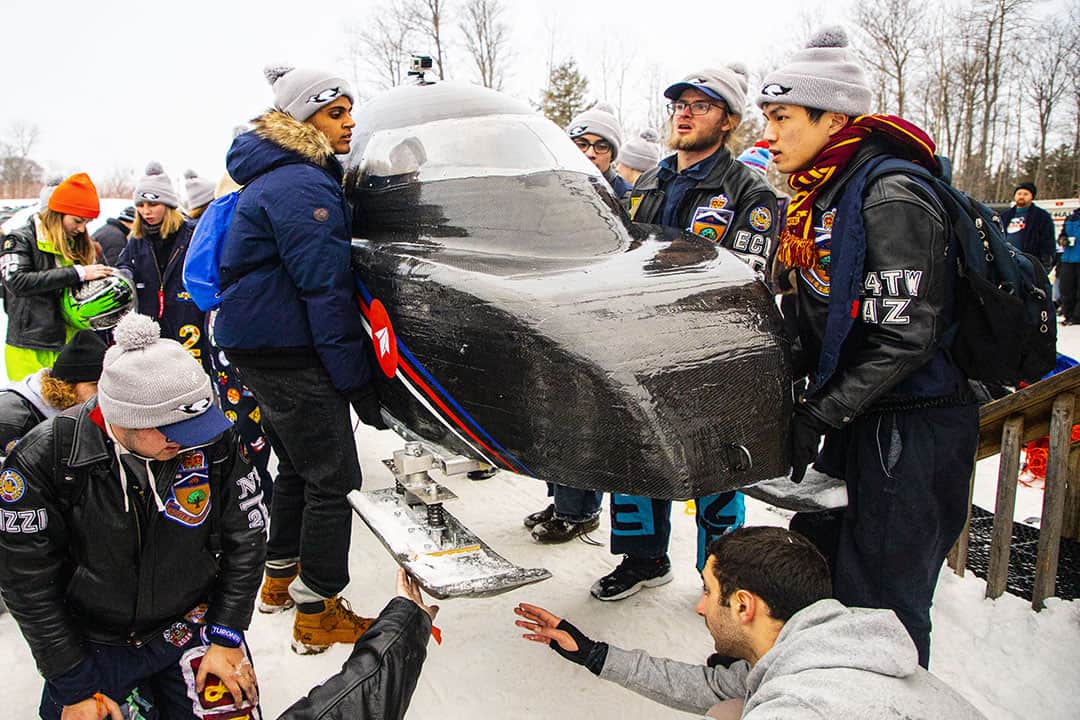University of Toronto engineering students glided to first place in the annual Great Northern Concrete Toboggan Race (GNCTR) on February 1 with their sleek carbon fibre-shelled toboggan. The win was a first for the U of T group, who stole the show this year while wearing outfits inspired by the uniforms of Canada Post workers.
What’s the race, anyway?
The GNCTR, this year hosted for the first time in Toronto, dates back to 1974, when the unique event was founded in Alberta. Today, it is the largest undergraduate engineering competition in Canada.
This year’s race, which followed the opening ceremonies and a technology exhibition earlier in the week, was held at Snow Valley Ski Resort just outside of Toronto. Teams from 21 faculties across Canada raced hand-constructed, independently engineered toboggans down the largest snow tubing hill in eastern Canada.
Engineering teams received awards in a number of categories, including superstructure design, safety, and innovation. Perhaps unexpectedly, artistic design was factored in — the U of T toboggan was plastered with a mock Canada Post logo reading “send it,” and the team members were outfitted as mail carriers. U of T’s team was determined to be the overall champion through a comprehensive scoring rubric with 10 categories.
What are the rules?
The rules for the competition are simple at first glance — teams must build a toboggan that is fitted with concrete skis, weighs less than 300 pounds, and has functional steering and braking. Next, the toboggan must be able to safely transport five riders in an enclosed roll cage, a protective structure around the occupant seats. Finally, they send said toboggan barreling down a large ski-hill at the highest speed possible, hopefully keeping all riders inside.
While the final push down the hill could be missed in the blink of an eye, the lead-up to this moment takes months of hard work. The engineering process for this year’s toboggan began in the fall, with concept art, material experimentation, braking, and steering systems already well into production by October.
Innovative assets by U of T
Michael Lizzi, co-captain of the U of T team and an engineering science undergraduate student, explained some of the new and innovative assets included in this year’s toboggan in an interview with The Varsity. Starting with its distinguished design and safety features, he noted that “being a closed pod is definitely unique.”
“Something new this year is we have rider isolation built in, which is that the whole front nose cone past the windshield area is an isolated crumple zone.”
It is easy to see why safety is a big priority for the team. Accidents and rollovers are common, and medics wait attentively on the sidelines of the hill in case of emergency.
The venue on race day
Despite the potential dangers, the venue on race day was electric — loud music could be heard from the parking lot, competitors strutted in colourful coveralls, and impromptu dance routines broke out every few minutes in the crowd. A surreal moment that captured the eccentric fun of the event was the surprise appearance of an engineering student marching band, complete with drummers and trumpets.
While the Royal Military College of Canada (RMC) team did not place, they seemed to have won the hearts of competitors and spectators by filling the role of impromptu rescuers — a loud chanting of “RMC!” could be heard every time the camouflage-clad team rushed onto the hill to carry off one of the many crashed toboggans.
Determination in absurdity
U of T’s engineering team participated in the fun and friendly antics, but in true U of T fashion, they also took their work very seriously. While many competitors were warming by the fire, sipping hot chocolate, or joining the spontaneous marching bands, most U of T team members could still be seen tinkering with their meticulously built carbon fibre-based toboggan, making sure everything was perfect for the race. In the end, the relentless U of T enthusiasm paid off, earning them recognition and top place.
This sense of determination to pursue excellence, even in the face of absurdity, seems to define the spirit of the GNCTR. As the sounds of trumpets faded away and engineering students boarded their buses to depart for closing ceremonies, one thing seemed clear — perhaps only an engineer could think of an idea like a concrete toboggan race, and only engineering students could be daring enough to pull it off.


